Refugee integration - role of local authorities: research
Research commissioned by the Scottish Government to explore and assess the role of Scotland’s 32 local authorities in supporting the integration of refugees and people seeking asylum.
3. Understanding the current picture
This chapter sets out how local authorities in Scotland manage humanitarian protection programmes and support refugee integration. Drawing on evidence from the research survey and immigration data, it details the wide-ranging efforts made by local authorities to provide support to refugees and people seeking asylum, including how they approach collaboration and partnerships with other organisations.
Refugee resettlement across Scotland
As explored in Chapter 1, local authorities have been at the forefront in delivering a series of major new resettlement schemes which have been put in place since 2014. While before this period resettlement numbers were very low and many local authorities in Scotland had no experience of supporting humanitarian protection programmes, councils have scaled up their work over time and all 32 of Scotland’s local authorities are now involved in refugee resettlement.
Figures 3.1 and 3.2 below illustrates some of the changes in refugee arrivals which local authorities in Scotland have responded to since 2014. As Figure 3.1 shows, resettlement numbers under the VPRS increased significantly between 2014 and 2020. During the pandemic period in 2020, resettlement in effect stopped. However, as illustrated in Figure 3.2, the number of arrivals increased significantly during 2022 under the Ukraine Sponsorship Scheme. (There have also been large numbers of arrivals since 2021 through the Afghan schemes – while time series data is unavailable, 968 people on Afghan schemes were in Scotland as at 31 March 2023.) The charts highlight how local authorities across Scotland have had to continually adapt to unpredictable and fast-moving refugee patterns in recent years. Figure 3.2 illustrates how the number of arrivals under the Ukraine Sponsorship Scheme increased significantly during 2022 and a more graduated increase through much of 2023.
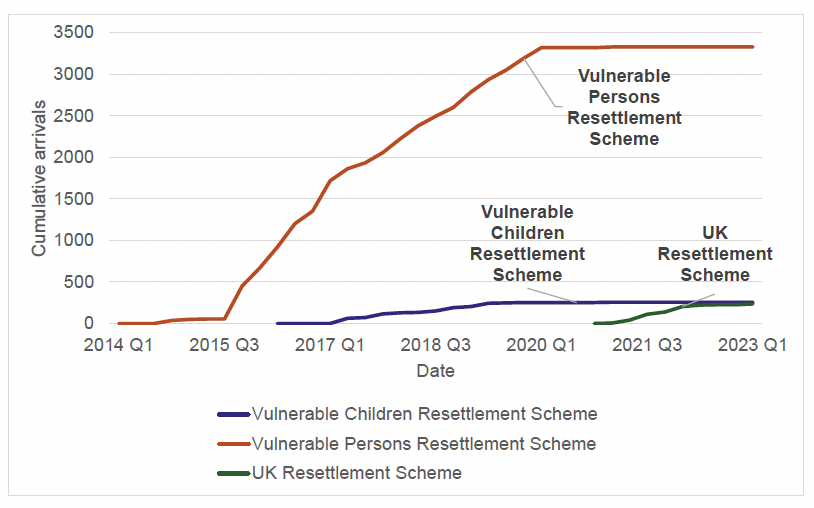
Source: IPPR analysis of Home Office 2023b Note: ARAP/ACRS are not included.
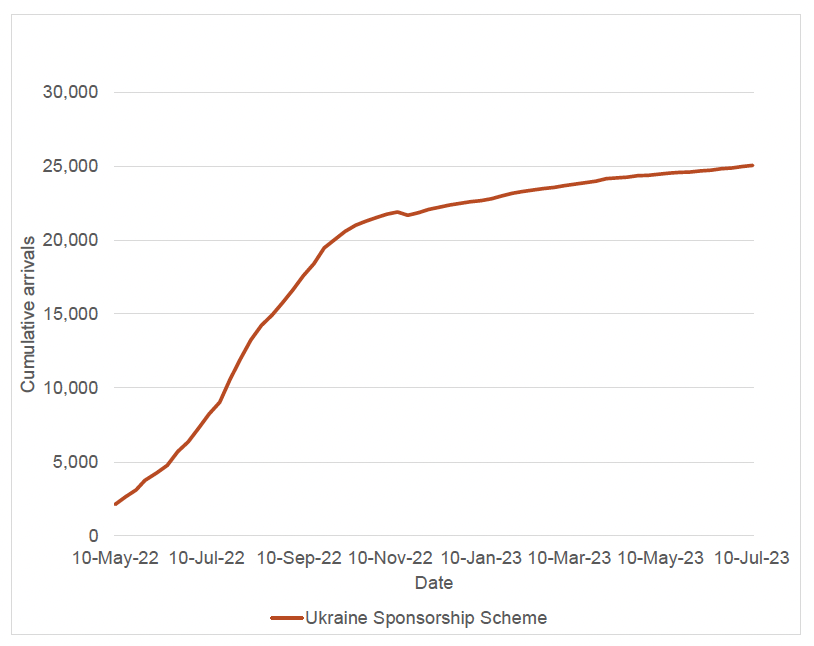
Source: IPPR analysis of Home Office 2023h
Sponsorship Scheme refer to the number of Scotland arrivals on a weekly basis as published by the UK Government. Figures for the Ukraine Sponsorship Scheme continued to increase significantly in late 2022. From 22nd Nov 2022, the analytical methodology to de-duplicate the arrival figures at the local authority level was amended to be consistent with Home Office reporting; therefore, any decrease in the figures compared to previous releases may be a result of this deduplication. This has had the effect of a small dip in what is otherwise a cumulative figure which gradually increases.
To illustrate the breadth of involvement across Scotland, Figure 3.3 shows the local authorities where refugees have been resettled under the VPRS, the resettlement route involving the largest numbers of refugees (outside of the bespoke Afghan and Ukraine routes). All of Scotland’s 32 local authorities resettled refugees under the VPRS, most in at least double digits. Out of a total of 3,328 refugees resettled under the VPRS since 2014, the local authorities receiving the largest numbers include Edinburgh (484 refugees), Glasgow (366 refugees), North Ayrshire (201 refugees), Aberdeenshire (176 refugees), and Dundee (170 refugees) – a mix of both urban and rural areas (Home Office 2023b).
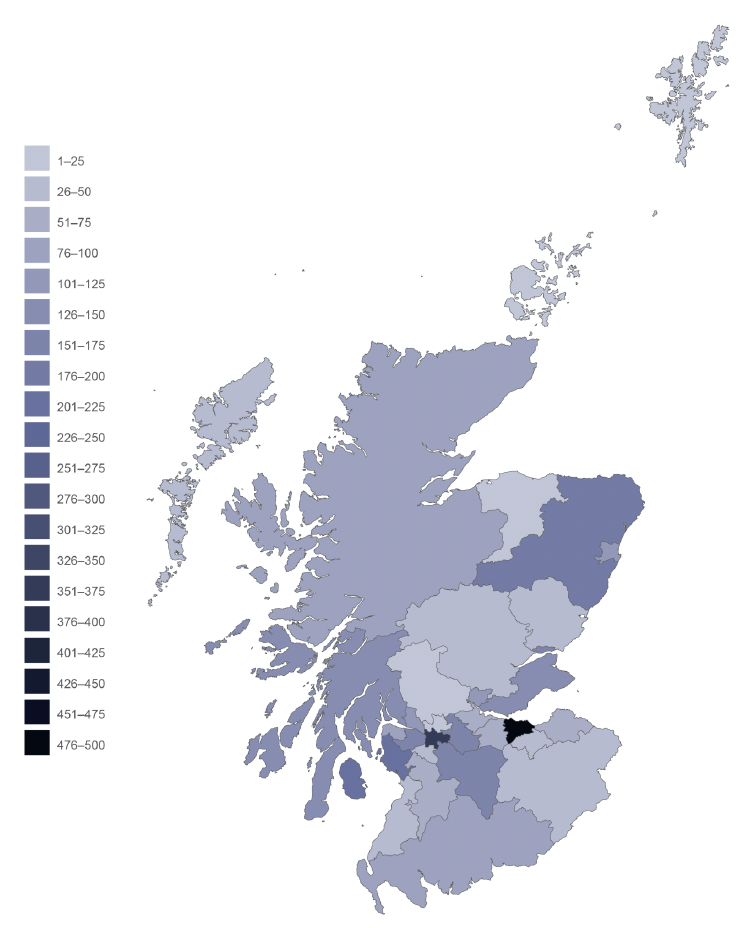
Source: IPPR analysis of Home Office (2023b)
However, the pattern of resettlement across Scotland varies depending on the precise route. Of those resettled under the VCRS (a total of 256), more than half (155 or 60%) of the total number of people resettled were resettled in Glasgow. Of those resettled under the UKRS so far (a total of 235), around half (49%) have been resettled in Edinburgh. These resettlement routes are therefore more concentrated in Scotland’s largest cities. The UKRS is however in its early stages and these figures are likely to change as the route develops.
For the Afghan schemes, as at 31 March 2023 people in bridging accommodation were located in Aberdeen (143), Edinburgh (109), and Fife (56). Those in settled accommodation, however, were most commonly living in Glasgow (124), Edinburgh (109), and Inverclyde (78) (Home Office 2023g).
Different patterns emerge again with the new Ukraine schemes. Figures 3.4 and 3.5 illustrate where refugees have settled in Scotland under both the Super Sponsor Scheme and the Individual Sponsor Scheme, according to the available data. The local authorities with the largest numbers of guests who have arrived at longer-term accommodation under the Super Sponsor Scheme include Edinburgh, Aberdeen, South Lanarkshire and Renfrewshire. The local authorities with the largest number of guests under individual sponsorship include rural areas such as Fife, Perth and Kinross, and Highland, as well as Edinburgh (ibid). This may be because households in rural areas are more likely to have spare rooms to host guests as individual sponsors.
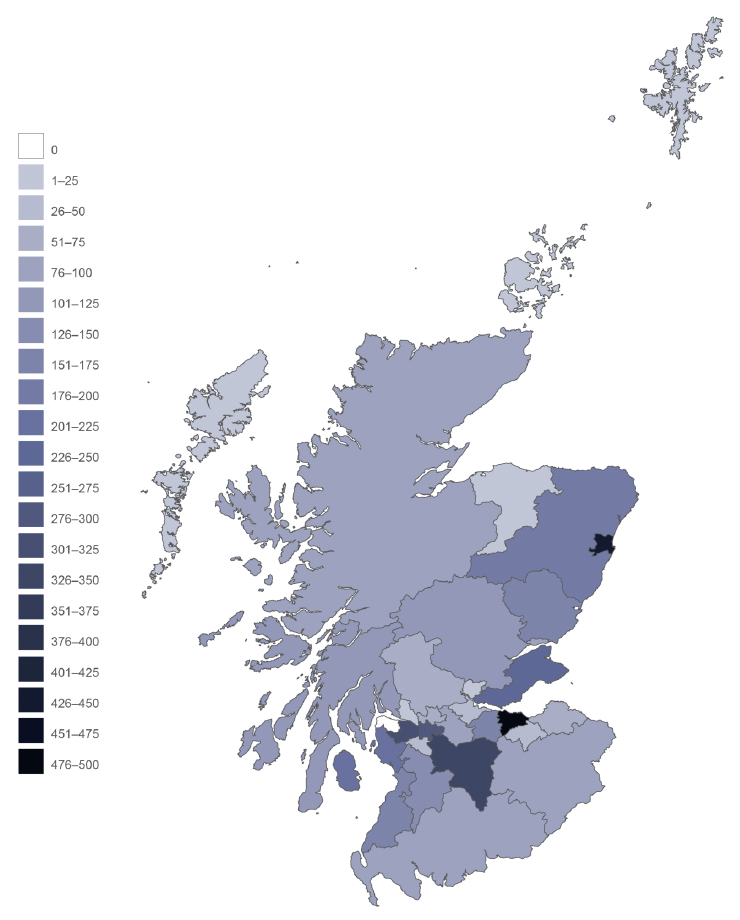
Source: Scottish Government 2023d
Note: Based on provisional data and may underestimate completed matches. All figures rounded to the nearest 5 due to disclosure control.
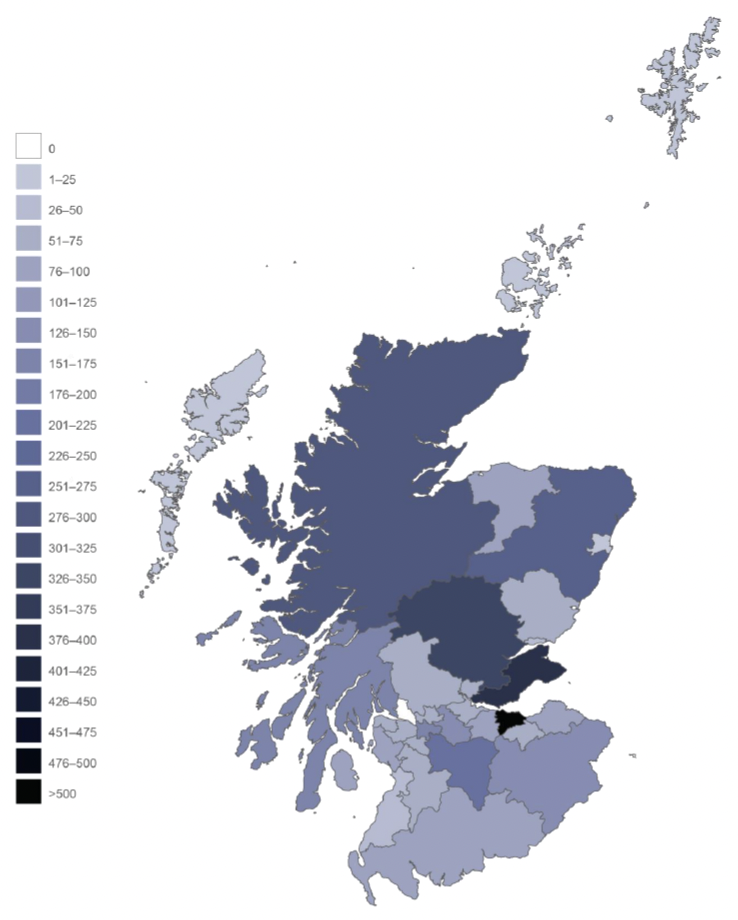
Source: Scottish Government 2023b
Note: All figures rounded to the nearest 5 due to disclosure control.
As explained in the introduction, the move to full dispersal in the asylum system and to a mandated National Transfer Scheme for unaccompanied asylum-seeking children – as well as the growing use of temporary accommodation by the Home Office – mean that people seeking asylum are increasingly being accommodated across different parts of Scotland.
There are early signs of this shift in the latest available data from the Home Office. As at 31 March 2023, the vast majority (89%) of people seeking asylum in receipt of support were in Glasgow, but there were recent sharp increases in people seeking asylum in receipt of support in other local authorities. For instance, Perth and Kinross had eight people seeking asylum in receipt of support on 30 September 2022, increasing to 106 on 31 December; while Aberdeen had nine people seeking asylum in receipt of support on 30 September, increasing to 107 on 31 December. There were also sharp increases in Edinburgh, Falkirk, Inverclyde, Renfrewshire, and South Lanarkshire (Home Office 2023i). Most of this appeared to be driven by the use of contingency accommodation in these areas, and not yet the move to full dispersal.
Moreover, Home Office transparency data indicate significant increases in UASC transferred to local authorities in Scotland via the National Transfer Scheme in recent years. In the first quarter of 2021, five transfers were made into Scottish local authorities (including from ports/intake units), whereas in the first quarter of 2023 there were a total of 55 transfers. The number of transfers has ranged considerably between local authorities: in the year ending March 2023, some local authorities had zero or 1-2 transfers, while others had significantly higher numbers, including Aberdeenshire (30) and Highland (27) (Home Office 2023k).
This analysis shows that, since 2014, all local authorities across Scotland have been actively facilitating refugee resettlement. While many did not have experience before then, the roll-out of the VPRS meant that for the first time many local authorities were tasked with new responsibilities for integrating refugees and needed to quickly develop new expertise and ways of working. Given the UK Government’s move to full dispersal and the mandated NTS, local authorities are now also becoming more involved in supporting people seeking asylum – particularly with respect to unaccompanied asylum-seeking children, where they have a range of responsibilities. The following section explores how local authorities carry out their responsibilities for delivering humanitarian protection programmes.
How local authorities deliver refugee integration activities
Local authorities typically deliver the bulk of their refugee integration work through refugee resettlement teams. These teams are part of the council and lead on supporting refugees who arrive in the local authority area through different resettlement programmes. They are responsible for coordinating provision for resettled refugees, including welcoming people on arrival, arranging accommodation, and ensuring registration and access to relevant services. Resettlement teams are generally funded through the Home Office, according to the tariff funding for the different resettlement schemes discussed in Chapter 1. Support for unaccompanied asylum-seeking children is typically staffed separately through children’s services.
The Scotland-wide survey of local authorities and partner organisations gave further insights into the role of resettlement teams. Based on the survey responses, the vast majority of local authorities in Scotland (30 out of 32) have a refugee resettlement team, and even among those who answered that they do not, the remaining two local authorities were in the process of either recruiting a team or awaiting for a newly recruited resettlement team leader and staff to assume their position.
However, these teams vary considerably in size: some local authorities (a total of 4) only had one full-time equivalent (FTE) staff member working directly for the council on the resettlement and integration of refugees and people seeking asylum, while other local authorities had more than 10 FTE staff members. This likely reflects the different scale of refugee arrivals across local authorities, with more rural areas tending to have fewer staff. However, it may also be partly due to differences in interpretation of the question (e.g. whether or not respondents included ESOL teams), as well as varying models across local authorities (e.g. whether councils contract out services to partner organisations).
The survey also asked respondents how long their local authority had been supporting refugees and/or people seeking asylum, in order to understand the histories and experiences of local authorities in delivering refugee integration activities (Fig 3.5). For most local authorities, the median answer given was 6-10 years, reflecting how resettlement efforts have been scaled up since the introduction of the Syrian Vulnerable Persons Resettlement Scheme in 2014. For some local authorities, less experience was indicated – for instance, the answer for Angus, East Ayrshire, East Renfrewshire and Moray was less than five years – while for other local authorities (e.g. Glasgow and East Lothian) it was suggested that there were longer periods of experience.
Together, these answers highlight the changing nature of refugee resettlement across Scotland, whereby the introduction of new resettlement schemes have meant that an increasing number of local authorities across Scotland have become actively engaged in the refugee resettlement process. It also indicates the value in sharing learning between local authorities, given the years of experience and expertise in local authorities with a longer history of managing refugee resettlement schemes and, in Glasgow’s case, asylum dispersal.
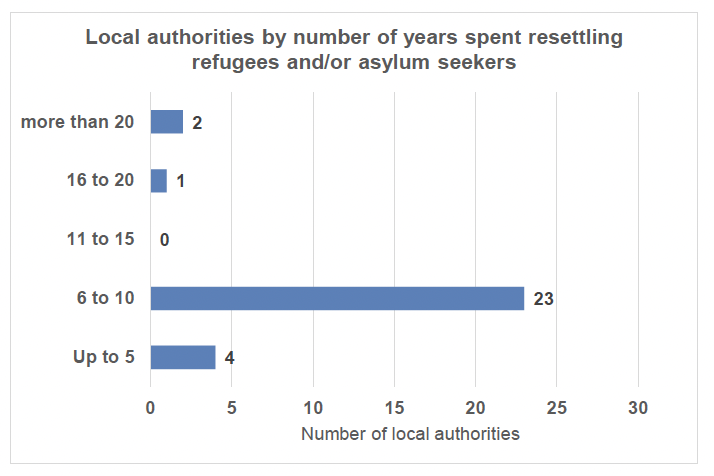
Source: IPPR analysis of local authority survey/interviews (median answer by local authority)
Additional interviews with council officers highlighted further details about the workings of resettlement teams. The interviews suggested some important differences between local authorities. While urban local authorities tended to have large and established resettlement teams, this was harder to do in rural local authorities due to what one interviewee described as ‘diseconomies of scale’. As the interviewee explained, smaller local authorities struggled to secure enough Home Office funding to set up a fully-fledged resettlement team, given they were only resettling small numbers and funding was available on a per-person basis. This meant that staff had often had to work on resettlement alongside their day-to-day roles, leading to burnout and high turnover. This suggests that the tariff structure of Home Office funding – and the uncertainty in predicting future numbers – can make it hard for local authorities to properly and sustainably resource their resettlement teams.
Council staff also discussed how resettlement teams had developed and grown in their local authorities. One interviewee noted that, in general in local authorities, resettlement work emerged out of housing teams, though this was not always the case – the interviewee in question had originally been a social worker, while another council officer spoke of staff members coming from a community development background. The development of refugee resettlement teams shaped their priorities and focus: for instance, in the case of Dundee, whose team developed out of social services, social work was placed at the centre of their approach (e.g. all adults were given a social work assessment on arrival).
A further point emphasised by one council refugee resettlement lead concerned the need to secure buy-in from across the local authority for humanitarian protection and refugee integration activities – in particular within social work and housing teams, who could often be quite removed from resettlement work. In their words, it was a “deliberate strategy from the start to ensure that refugee resettlement was a responsibility across the council”. By playing the role of a coordinator and bringing different elements of the council together on these issues, the resettlement lead explained that they helped to build knowledge and understanding of refugee integration across different council teams.
As part of building a picture of how local authorities delivered humanitarian protection programmes in Scotland, it was important to understand the extent to which they took a strategic approach to refugee resettlement. As explained in Chapter 1, the Scottish Government, COSLA and the Scottish Refugee Council have jointly developed the New Scots Refugee Integration Strategy, which provides a framework for refugee integration work across Scotland; it was therefore important to understand whether local authorities had responded by developing their own strategic approaches. In the survey, respondents were asked whether their local authority had a defined refugee integration strategy in place. Out of the 32 local authorities, respondents indicated that 13 had such a strategy, while in the remaining cases respondents said either there was no strategy or they were unsure (Figure 3.7).
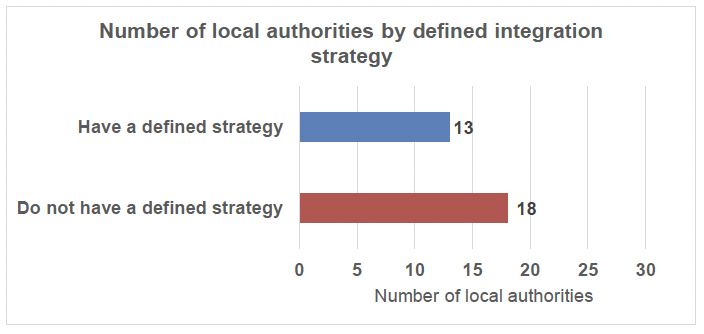
Source: IPPR analysis of local authority survey/interviews
*Does not sum to 32 as one local authority provided the response ‘Don’t know’
The interviews with resettlement leads offered some further insights into how local authorities had developed strategies for refugee integration. One council officer explained that they did not have a bespoke local strategy of their own, but they “work broadly to the New Scots integration strategy”. This suggests that some of those local authorities that said they did not have a strategy may have been using the Scotland-Wide New Scots Refugee Integration Strategy as the framework for their integration activities.
A common theme in the interviews was the challenge in balancing strategic and operational priorities. One interviewee said that their council had recently agreed a new paper underpinning the different resettlement schemes, but this now needed a re-evaluation in light of the new policies for Ukrainians. An interviewee from a different local authority said that the council was hoping to develop a more strategic approach but, given the pressures and limited resources of the team, “at the moment we are purely focused, really with the needs [of new arrivals] and delivering at an operational level”. The recent new Afghan and Ukraine schemes therefore appear to have made it particularly challenging for local authorities to focus on an overall refugee integration strategy due to the schemes’ pressures reducing the available time for strategic thinking.
Nevertheless, the additional interviews with council officers also highlighted the commitment and flexibility of local authorities in the face of a series of recent crises, from shifting rapidly to online learning during the Covid-19 lockdown to managing accommodation and integration support for the surge of arrivals through the new Ukraine schemes. For instance, one council spoke of organising daily multi-agency meetings with 20-30 different partners in the initial two months of the Ukraine response. In the words of one interviewee, Scotland’s local authorities were ‘very good at responding to emergencies’. This flexibility was a hallmark of local authority approaches to refugee integration, as explored in further detail in the following chapters of the report.
How local authorities coordinate their integration activities with others
As discussed in Chapter 1, the delivery of refugee integration work in Scotland involves a balance of responsibilities between the UK Government, the Scottish Government, COSLA, local authorities, and other public and third sector providers. Effective cooperation between these groups is essential to successful refugee integration.
The survey asked respondents how closely their local authority coordinated with different institutions and organisations – including COSLA, the Scottish Government, the UK Government, local third sector organisations, other local authorities, and other local public service providers (e.g. Health Boards, education providers and the police) to deliver humanitarian protection programmes and support the integration of refugees and people seeking asylum. Respondents were asked to choose between four responses indicating different levels of closeness in local authority coordination. This ranged from ‘0 - No coordination’, ‘1 - Limited coordination’, ‘2 - Fairly coordinated’, to ‘3 - Highly coordinated’ (see Figure 3.8). An average of responses per local authority was then taken as an overall national average.
COSLA’s Strategic Migration Partnership received the highest overall average response rate at 2.7 out of a possible 3, indicating high levels of coordination by local authorities with COSLA. This reflects COSLA’s central coordination role in Scotland – for instance, through matching resettled refugees to local authorities, managing the NTS rota, and organising monthly/fortnightly meetings for local authority resettlement leads.
There were high average scores for coordination with third sector organisations (scoring an average of 2.3) and local public service providers (2.6). This reflects the joint partnership working taking place at the local level to deliver integration support, which will be discussed in more depth in the following chapter.
There was also a high average score for coordination with other local authorities (2.5), suggesting that there is a fairly strong degree of sharing of knowledge and best practice on refugee integration between councils across Scotland. Over the course of the project, researchers heard of particular examples of effective partnership working between local authorities. For instance, North and South Lanarkshire resettlement teams work closely together, providing peer support and sharing resources, and have developed a joint piece of work with NHS Lanarkshire, the regional Health Board. Another example is the partnership approach of North, East and South Ayrshire, including joint working between the three local authorities under the EU Asylum, Migration and Integration Fund (AMIF).
Average scores were lower for the Scottish Government (average score of 2.2) and, in particular, the UK Government (average score of 1.8, falling between limited coordination and fairly coordinated). This could be because the Scottish and UK Governments are less involved in the operational delivery of integration support at the local authority level compared with the other organisations listed above, and because they tend to coordinate with local authorities via COSLA rather than directly with local authorities. It may also reflect recent challenges with delivering the Afghan and Ukraine schemes, as well as the NTS. Interviews conducted for the case studies corroborated this by highlighting problems with how the schemes had been organised and communicated by the UK Government.
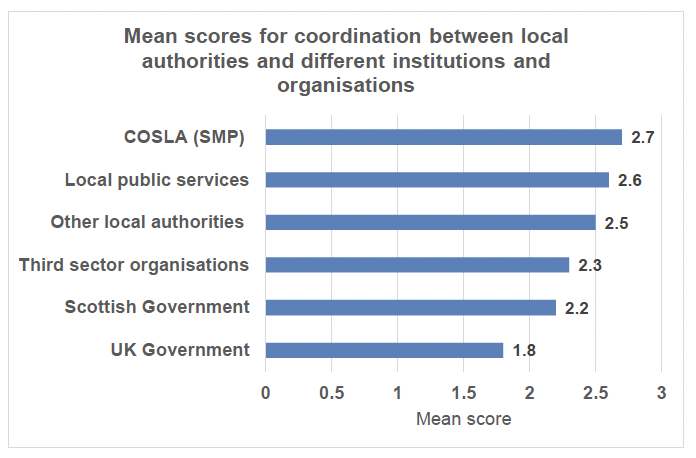
Source: IPPR analysis of local authority survey
The role of lived experience
One of the overarching outcomes of the New Scots Refugee Integration Strategy is to ensure that policy, strategic planning and legislation impacting on refugees and people seeking asylum are informed by their own needs, rights and aspirations. The research therefore aimed to explore the extent to which the lived experience of refugees and people seeking asylum help to shape integration policy and processes at the local level. The survey asked respondents to determine to what extent their local authority succeeded in incorporating the views and experiences of refugees and people seeking asylum in their policy and strategic planning. Responses ranged from ‘0 – Not incorporated at all’, up to ‘4 – Highly incorporated’.
The national average score, taken from the average score for each local authorities, was 2.7. This is higher than the mid-point between 0 and 4, suggesting that on average local authorities are to some extent incorporating the views of refugees and people seeking asylum, though there is also room for improvement. Importantly, respondents to this question will only present a partial view, given they represent the voices of local authorities and partner organisations; for a fuller account, a survey would need to be conducted for those with lived experience of the refugee and asylum system, but this was outside the scope of this research project.
Through the survey, respondents were able to provide written responses to elaborate on why they provided the score they did. These answers reflected a range of mechanisms for incorporating the views of refugees and people seeking asylum, including feedback forms and surveys, focus groups, and more informal means of engagement.
The responses suggested local authorities made concerted efforts to get input from refugees and people seeking asylum, but to varying degrees of success. One local authority noted that they conduct home visits and drop-in sessions on a weekly basis to understand people’s needs and make improvements. Another respondent explained how their local authority benefited from a Syrian Network (now developing into a New Scots Network), which fed into the Community Board level decision making and council planning. However, other respondents said that their efforts to incorporate views of refugees and people seeking asylum were still in their infancy and that limits on capacity and Covid-19 had made it harder to carry out this type of engagement.
Local authority approaches to refugee integration: Overview of the three case study areas
The research for this report involved in-depth analysis in three case study areas: Aberdeenshire, Dundee, and Na h-Eileanan Siar. This section provides an overview of each of the case study areas and their approaches to delivering humanitarian protection programmes and supporting refugee integration. The information presented here is based on interviews and focus groups with staff from the three local authorities, other local service providers, and third sector and community organisations, as well as refugees and people seeking asylum.
Aberdeenshire
Aberdeenshire is a geographically large rural local authority in the north-east of Scotland. The borders of Aberdeenshire stretch from Moray in the west, along the North Sea coast, around the periphery of the City of Aberdeen (which is a separate urban local authority), south towards Angus, and extending deep into mountainous Cairngorms in the west. The large geography of Aberdeenshire accounts for the local authority’s low population density, with the population spread across multiple towns separated by extensive farmland. Despite this the overall population is relatively high with more than 260,000 residents according to latest estimates (Aberdeenshire Council 2022a). Peterhead, Inverurie, and Fraserburgh are among the largest urban areas in terms of population, with the council identifying 18 ‘main towns’.
While Aberdeenshire is serviced by several railway stations, they are limited to two connected lines running north along the North-East Mainline to Aberdeen, and a link between Aberdeen and Inverness. Therefore, car and bus travel act as the primary link between Aberdeenshire’s dispersed population centres and access to health, social, and cultural services, with 10% of every kilometre of Scotland’s roads located in Aberdeenshire (Aberdeenshire Council 2018). The area is serviced by bus routes operated by Stagecoach as well as community transport initiatives throughout the various towns of Aberdeenshire and a free Dial-A-Bus service operated by the council to maximise personal mobility.
Traditionally, agriculture and fishing dominated Aberdeenshire’s economy; however, with the discovery of oil and gas in the North Sea in the 1970s, the energy sector features as the focus of today’s economy. This has led to a consistently lower unemployment rate compared with the Scotland average, and higher average household income (Aberdeenshire Council 2021; Aberdeenshire Council 2022b). The growth of the energy industry has coincided with an increase in the population, and in 2020-21 Aberdeenshire had the fourth highest net total migration level (total internal and external to Scotland) of Scotland’s local authorities (National Records of Scotland 2022a). A traditionally ethnically homogeneous area of Scotland with low levels of migration, the energy industry has attracted migration from around the world. Meanwhile, in recent years the number of refugees resettling in Aberdeenshire has increased with a corresponding development of Aberdeenshire’s resettlement team in staff, capability and experience.
Aberdeenshire’s approach to refugee integration
In Aberdeenshire, the local authority has coordinated integration support for resettled refugees since 2016 with the arrival of Syrian refugees under the VPRS. While significant numbers of Syrian refugees were resettled in the area, only a small number of Afghans have been resettled in recent years – reflecting the broader problems with the Afghan resettlement schemes. Similarly, at the time of interview, the local authority was struggling to attract Ukrainian displaced people – despite having a couple of hundred sponsors approved, they had only had a handful of matches under Homes for Ukraine.
At the same time, increasing numbers of UASC are being housed in Aberdeenshire – and while numbers at the time of fieldwork were relatively small on the whole (jumping from two young people at the end of 2021 to 10 by August 2022), the work to support these young people is significant.
The council takes a Community Learning and Development (CLD) approach,[10] in line with Scotland’s CLD policy and is underpinned by the Aberdeenshire New Scots Refugee Integration Strategy (Aberdeenshire Council 2022c; Education Scotland nd). Support is geared towards empowering refugees with the knowledge, skills and tools to be independent and advocate for themselves. Over time the resettlement team has learnt to balance an individualised approach with one that sets clear boundaries and supports self-development, in order to avoid refugees becoming over-reliant on the local authority and to promote their independence and agency.
“I think at the beginning we made the mistakes that most people make where we personalised and individualised a lot of the work that we did… we got very involved in every question and every answer… and then we thought, we can’t do this, this is too much. We’re over-personalising, we’re over-involving, people are becoming over-reliant. We then made very, very clear frameworks, so we let people know, this is what your resettlement officer does, this is how they will help you. They will help you develop your toolkit, they’re not the tools in your kit.” (Local authority worker)
As there is a small third sector in Aberdeenshire working with refugee communities, the council takes a very hands-on approach to resettlement work locally. Over time, the team has been restructured: while originally the resettlement lead sat in education and the rest of the team in housing, more recently the team was brought together under a manager responsible for tackling poverty and inequality, within business services. According to the team, this structure has been to their benefit, because rather than being placed within education, housing or social work and following the culture of that particular service, they have been able to focus on independently delivering on the outcomes they consider most important.
At the same time as the recent restructure, staff in the resettlement team had their salaries increased and their roles upgraded from housing officer to resettlement officers, in light of the specific knowledge and skills that they bring to the role. As a result, there is high staff retention and satisfaction among the team.
The council staff work with other public sector services, colleges, faith organisations and national third sector organisations to coordinate effective resettlement support. In addition, they work alongside the Friends of Al-Amal group, which was established after the arrival of Syrian refugees and supports the Syrian community locally to develop social connections through activities such as poetry nights, organised trips and community gardening initiatives.
There is a strong focus on multi-agency working in Aberdeenshire. For instance, one stakeholder, working to support children and young people in education, really welcomed being a part of multi-agency working groups such as the Refugee and Asylum Seeking Strategic Group and the Unaccompanied Asylum-Seeking Children Working Group. They said: “It’s really positive that we’re involved in conversations at those meetings because it means that we can feed in and also understand what’s going on. It’s working together.”
Dundee
Dundee City, located on the River Tay and a historic port city to the North Sea, is Scotland’s most geographically compact local authority, and the second densest by population after Glasgow. The local authority comprises exclusively the City of Dundee and the wider metropolitan area including Broughty Ferry in the east. In total, according to the most recent population estimate, the local authority is home to 148,100 residents (National Records of Scotland 2022b).
The city is served by two train stations (Dundee and Broughty Ferry) with rail connections to Perth and the Highlands in the west, the Central Belt through Fife to the south, and onward connections to the north-east of Scotland and Aberdeen. Dundee also has a small airport which provides primarily domestic flight connections. Within Dundee there is fairly comprehensive bus network operated by Xplore serving the city and metro area, and Stagecoach Strathtay connecting the city with the more rural Angus and Grampian regions to the north.
As Scotland’s fourth largest city, Dundee is home to a variety of services in close proximity, including health, social, and cultural services. The prominence of Dundee’s educational services, including universities and colleges, and high-tech jobs in computing and game design are a positive attraction for inward migration of students and young people from around the world. Despite a long history of migration from across Europe, Africa and east Asia, net migration in Dundee has been in decline in recent years (National Records of Scotland 2022b). However, an established and expanding refugee resettlement team has seen a similar increase to Aberdeenshire in recent years in response to the crises in Afghanistan and Ukraine, with a particular community-centred approach to resettlement.
Dundee’s approach to refugee integration
Dundee City Council has developed an established model of refugee integration since it first started resettling refugees in 2015. Outside the bespoke Afghan and Ukraine schemes, interviewees estimated that Dundee had resettled around 250 refugees, primarily from Syria and Iraq. More recently, the city has supported two Afghan families, but has otherwise struggled to find matches despite offering accommodation as part of the scheme. Difficulty making matches can be attributed to high refusal rates by people resident in bridging hotels under the Afghan schemes. This has had a particular effect on slowing down the resettlement process in Dundee.
Dundee has also supported significant numbers of Ukrainians over the past year: at the time of fieldwork, around 60 people had arrived under the Homes for Ukraine scheme, with 23 people in local authority housing and a further six houses in the process of being furnished. Finally, Dundee is also playing an active role in supporting unaccompanied asylum-seeking children, over and above the numbers allocated by the rota under the National Transfer Scheme.
Dundee’s model of refugee integration involves close working with the Scottish Refugee Council, which is contracted by the council resettlement lead to provide day-to-day support to refugees in the local authority area. Dundee City Council and the Scottish Refugee Council now share office space, which helps with coordinating provision. The council also contracts an employability staff member and ESOL workers and works closely with local authority leads in social work (children and families), social work (adults), education, police, DWP and NHS.
This multi-agency working forms the basis of Dundee’s Humanitarian Protection Partnership, which informs the wider Dundee resettlement strategy, allowing stakeholders from different professions and expertise to raise queries or issues related to cases, and come to resolutions on a monthly basis. This multi-agency working was praised in interviews with Dundee stakeholders who described the forum as a “lifeline” which means “There’s always someone that I feel I can go to if I have a query”. Both the local authority and the Scottish Refugee Council spoke positively about the partnership and the positive feedback they received from refugees.
The onset of the Ukraine crisis is now testing the success of this partnership working. For the Homes for Ukraine scheme, the resettlement team is involved in providing disclosure checks for hosts and arranging visits, and there is close working with the council’s homelessness team to raise any concerns and provide support if there are breakdowns in the relationships between guests and hosts.
The Scottish Refugee Council play a critical role in refugee integration in Dundee. They are the first point of contact for resettled refugees in the city, helping with issues such as benefits, housing, education, GP registration, and utilities. They take new arrivals around the city to orientate them and organise a WhatsApp group and newsletter sharing information about local activities. This work is supported by volunteers, some of whom are refugees themselves. There are also other key organisations which provide support to refugees in Dundee, including the council’s ESOL and Employability teams and other third sector organisations such as Dundee International Women’s Centre.
Na h-Eileanan Siar
Na h-Eileanan Siar is the most geographically diverse local authority in Scotland and is perceived to be among the more remote areas of Scotland. The archipelago off the west coast of mainland Scotland comprises 15 inhabited islands, the largest by population including Lewis, Harris, North Uist, Benbecula, South Uist, and Barra. The latest population estimate indicates there are 26,200 residents, a majority of whom reside on the largest islands of Harris and Lewis, where the single largest urban settlement, and administrative centre of Stornoway is located (National Records of Scotland 2022c; Comhairle nan Eilean Siar 2023). Na h-Eileanan Siar is the only local authority in Scotland where a majority of the population can speak Gaelic.
With the joint lowest level of population density (alongside Highland) among Scotland’s 32 local authorities, population centres are small and spread out across the archipelago. This makes connectivity between settlements difficult. Road travel is possible by car and bus services, though ferries are required to connect the three main island groups (Harris and Lewis; Benbecula, North and South Uist; and Barra), alongside three airports allowing travel between the islands and the mainland. The geography of the local authority means it can take a long time to traverse the length of the archipelago, with Stornoway hosting the main health, social, and cultural services of the local authority. Reliable access to the mainland (by ferry and plane) is crucial to access key services such as health provision.
The archipelago has been losing population considerably since the early 20th century with a history of emigration rather than immigration, though in recent years the population has stabilised at around 26,000 residents (National Records of Scotland 2022c). As a result, the local authority has an ageing population, with the 65-74 age demographic increasing by 39.5% between 2001 and 2021 (National Records of Scotland 2022c). In terms of resettlement efforts, the small population paired with the rurality and geographical conditions of the local authority has meant that until recently very few refugees have settled here. However, since the introduction of the new resettlement schemes in recent years, the local authority has developed a resettlement team and begun welcoming new arrivals.
Na h-Eileanan Siar’s approach to refugee integration
Na h-Eileanan Siar was new to refugee resettlement when it first started supporting refugees around six years ago. Resettlement in Na h-Eileanan Siar started with relatively small numbers: the local authority initially received two Syrian families, followed by a further group of around seven families under the Syrian Vulnerable Persons Resettlement Scheme.
Na h-Eileanan Siar has also supported an Afghan family via the Linda Norgrove Foundation, a private charity helping women and children in Afghanistan. While the council had offered accommodation for two more Afghan families, they were still waiting to receive them at the time of fieldwork. A small number of Ukrainians had arrived, but despite significant numbers of hosts signing up to the scheme, many were reluctant to move to the islands. At the time of fieldwork, there were also efforts underway to sponsor a refugee family under the government’s community sponsorship scheme. Finally, the local authority was supporting two unaccompanied asylum-seeking children who had been transferred from Kent (though numbers may have changed since fieldwork took place).
The scale of the voluntary and community sector in Na h-Eileanan Siar – and the size of the council’s resettlement team – are smaller than elsewhere, which means the nature of delivery is different. The council typically provides direct bespoke support to individuals, who are all well-known to the community. This support involves taking people to their house on their first night and acclimatising them, arranging registration for bank accounts, Universal Credit, GPs, dentists, and other appointments, supporting children with introduction into the education system, helping with housing issues, arranging ESOL, supporting work placements, and helping with other aspects of day-to-day living.
To support refugee integration, the council has recruited volunteers, who in many cases have grown close with the families they support. There is an active focus on multi-agency working: meetings involving the resettlement team, DWP, housing, education, police, and health are organised regularly in the run-up to a household’s arrival. Given the close-knit ties within Na h-Eileanan Siar, multi-agency work is often based on personal relationships between different council officers and external services, which lend a distinct personal approach to the delivery of refugee resettlement work across the local authority.
Key findings
Since 2014, local authorities in Scotland have scaled up their humanitarian protection programmes and refugee integration work in response to a series of new schemes. They have adapted flexibly to unpredictable refugee patterns, including a slowdown in the Covid-19 period and a rapid surge in arrivals in 2021 and 2022 with the introduction of the Afghan and Ukrainian schemes.
All 32 of Scotland’s local authorities have been involved in refugee resettlement. The local authorities which have resettled the most refugees under the Syrian Vulnerable Persons Resettlement Scheme include Edinburgh, Glasgow, North Ayrshire, Aberdeenshire and Dundee – a mix of both urban and rural areas.
Given the UK Government’s move to full dispersal and the mandated National Transfer Scheme rota, local authorities are now also becoming more involved in supporting people seeking asylum – particularly with respect to unaccompanied asylum-seeking children.
Local authorities typically deliver the bulk of their refugee integration work through refugee resettlement teams, which are responsible for coordinating provision for resettled refugees, including welcoming people on arrival, arranging accommodation, and ensuring registration and access to relevant services. The research survey suggests that the vast majority of local authorities in Scotland have a refugee resettlement team, though they vary considerably in size and level of experience.
Resettlement teams have developed within their local authorities in different ways – some developing out of housing teams, and others from community development or social work. This has played a role in shaping their priorities and focus.
Out of 32 local authorities, survey responses indicated that around 13 had a defined refugee integration strategy. A common theme highlighted was the challenge in balancing strategic and operational priorities: the recent surge in arrivals from Afghanistan and Ukraine have made it particularly challenging for local authorities to focus on strategic thinking. At the same time, it was clear that local authorities had responded with speed and flexibility to a series of recent crises, from the Covid-19 lockdowns to the operation of the new Ukraine schemes.
The survey suggested that local authorities coordinate most effectively with COSLA, reflecting its central role in matching resettled refugees to local authorities, managing the NTS rota, and organising regular meetings with council officers. Respondents also indicated high levels of coordination with third sector organisations, public service providers and other councils, reflecting the effective partnership working within and between local authorities.
The three case studies for this report – Aberdeenshire, Dundee and Na h-Eileanan Siar – each have their own approaches to refugee integration:
Aberdeenshire takes a Community Learning and Development (CLD) approach, underpinned by its own refugee integration strategy. Support is geared towards empowering refugees with the knowledge, skills and tools to be independent and advocate for themselves. Recently the team has been restructured and brought together from different services under a manager responsible for tackling poverty and inequality within business services. This has helped the team to focus independently of other services on delivering their own outcomes.
Dundee’s model of refugee integration involves close working with the Scottish Refugee Council, which is contracted by the council resettlement lead to provide day-to-day support to refugees in the local authority area. The council also contracts an employability staff member and ESOL workers and works closely with local authority leads of other services. This multi-agency working forms the basis of Dundee’s Humanitarian Protection Partnership, which informs its wider refugee resettlement strategy.
Na h-Eileanan Siar’s approach to refugee integration involves direct personalised support by council officers and volunteers, who are recruited by the council. This reflects the smaller scale of the voluntary sector in the local authority and the lower levels of refugee resettlement. There is an active focus on multi-agency working, which is often based on personal relationships between council officers and external services, lending a distinct personal approach to the delivery of refugee resettlement work.
Contact
Email: socialresearch@gov.scot
There is a problem
Thanks for your feedback